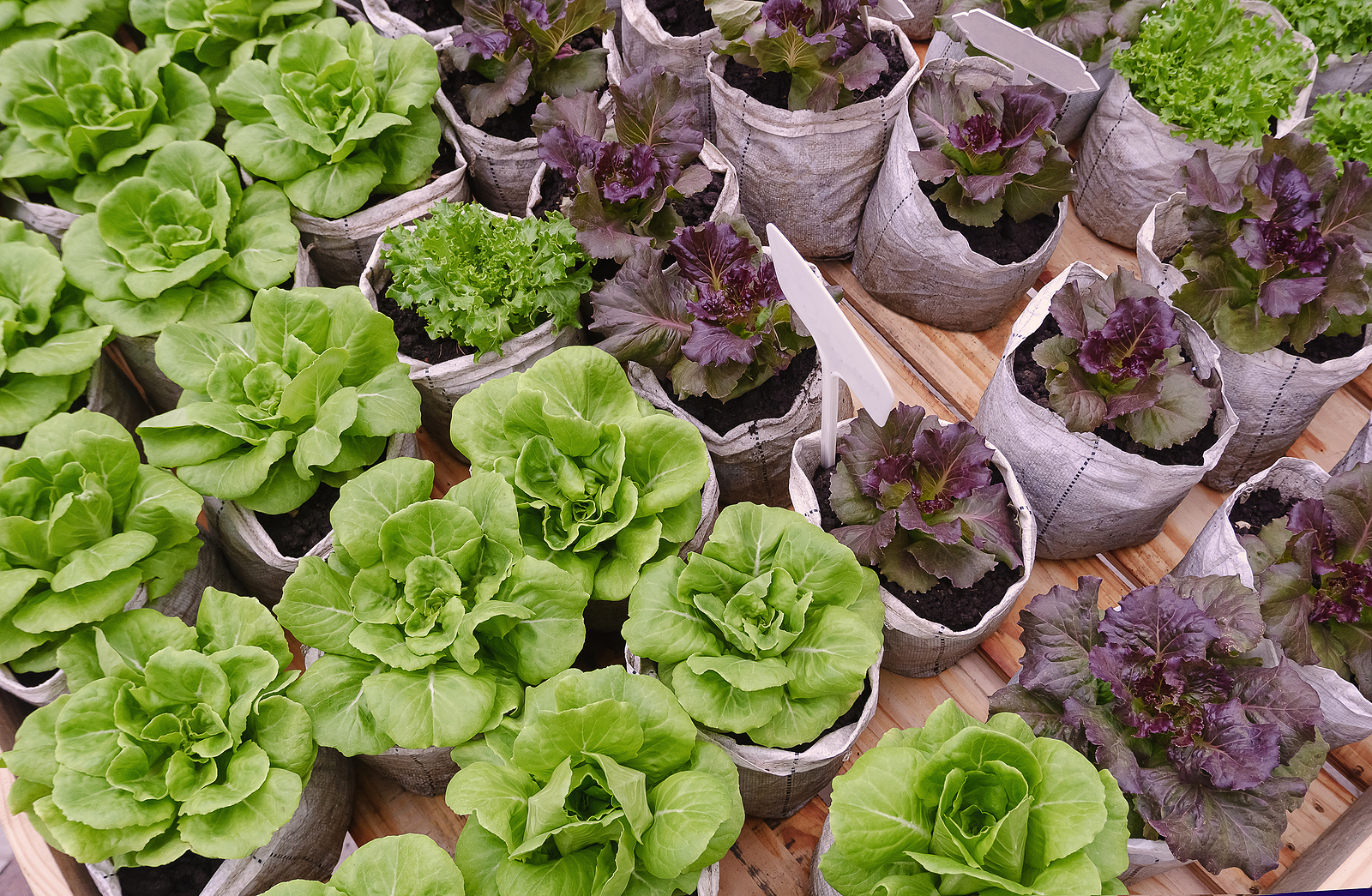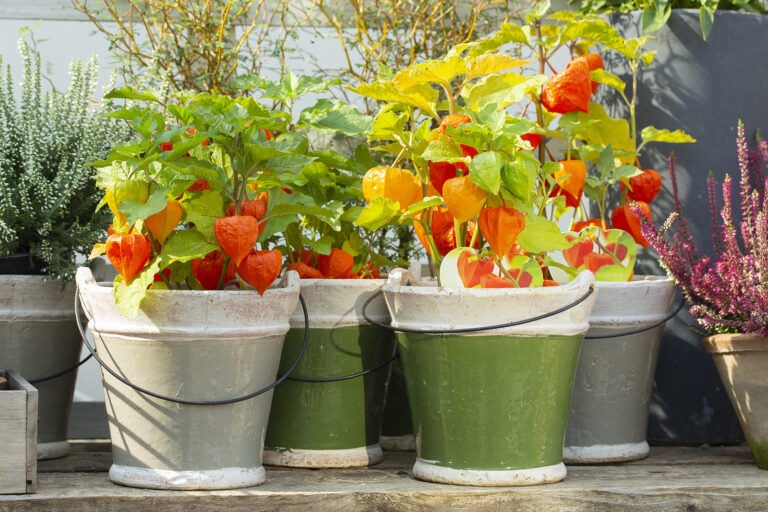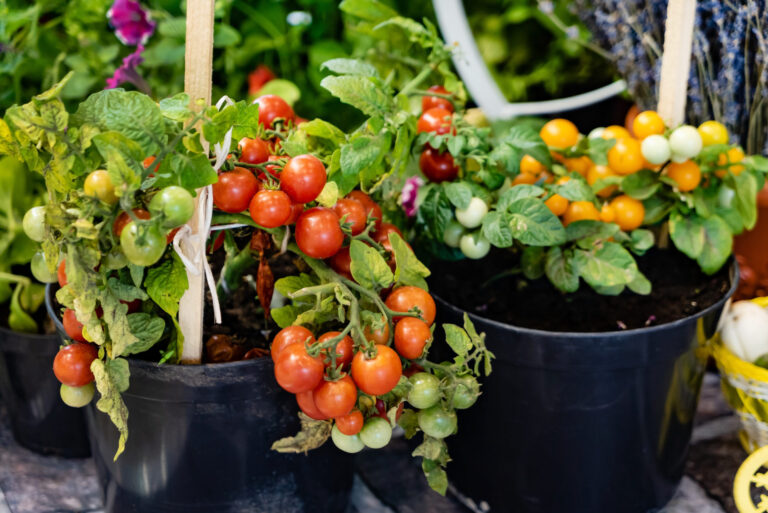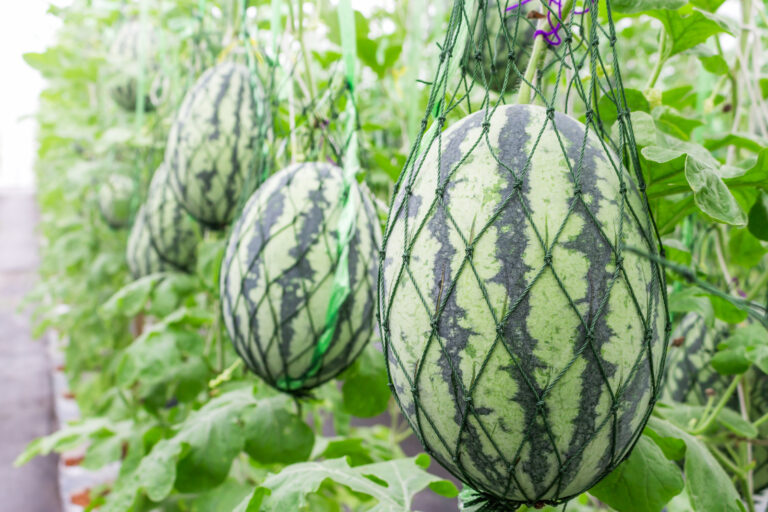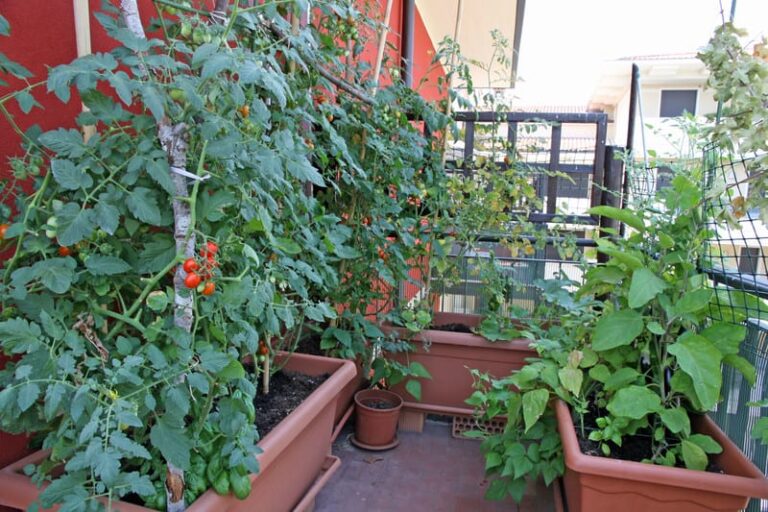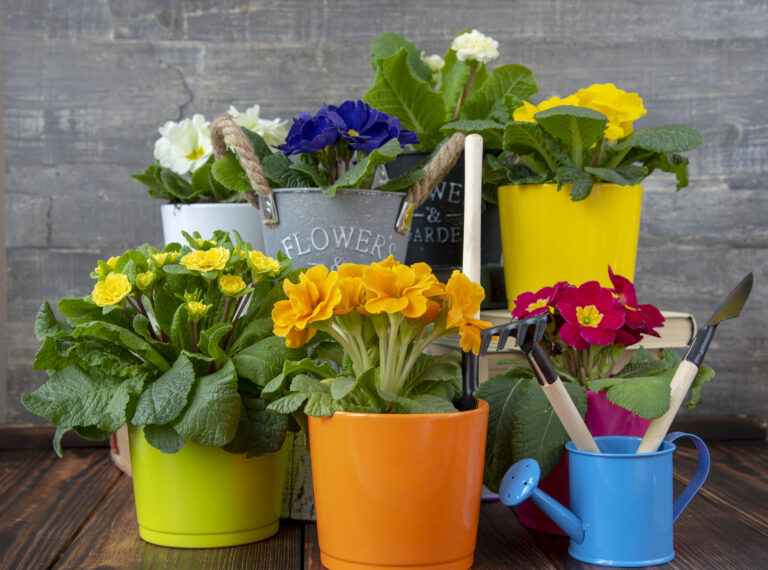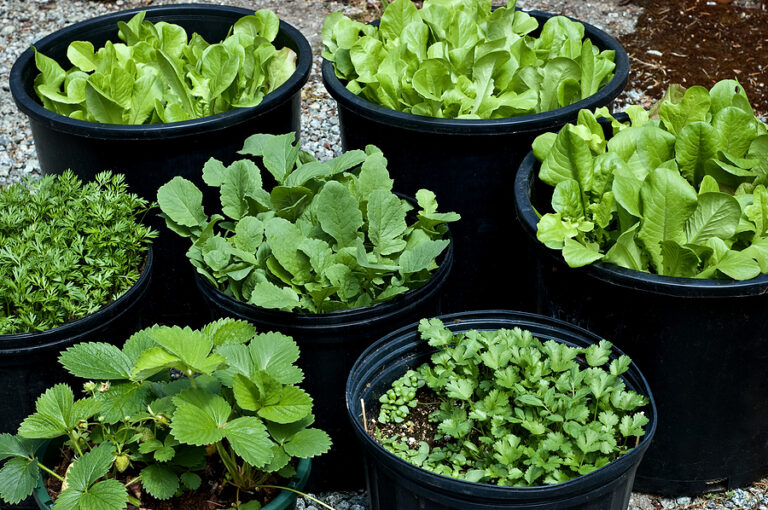Grow Bags Gardening Tips for Abundant Harvests
You can grow just about any vegetable in grow bags that you can grow in a regular garden—even melons and winter squash if the bag is large enough. There are only a few vegetables, such as asparagus, that aren’t really suited for grow bag gardening.
Even though grow bags are more limited in space than an in-ground garden, they offer one great advantage—you can reach your entire garden in just a few steps. There aren’t many farmers or gardeners that can reach their crops in just a few steps out the door.
Container Garden Products at Amazon:
- Gardzen 10-Pack 10 Gallon Grow Bags
- Raised Bed on Wheels for Vegetables
- Self-Watering Planters for Vegetables
- Harris Neem Oil Plant Disease Control
When choosing crops for your grow bag garden, choose vegetables and varieties that offer a big harvest without taking a lot of space or time. Two ways to get a lot out of your grow bag garden is to choose crops that have big yields and mature quickly. Here are a few suggestions:
Big-yield vegetables for grow bags
- Beets*: 16-20 per 8-inch bag
- Bush snap beans: 10-20 bunches per 5-gallon grow bag
- Carrots*: 16-60 per 8-inch grow bag
- Lettuce: 10-20 salads per 3-4 gallon grow bag, pick leaves as needed
- Onions*: 30 green onions per 4-gallon grow bag
- Radishes*: 30-40 per 5-gallon grow bag
- Tomatoes: 30-100 cherry tomatoes per 7-gallon grow bag
- Zucchini: 10-40 per 5-gallon bag
*growing successions
Vegetables that mature quickly
- Bush snap beans: 45 days
- Kale: 55 days
- Loose-leaf lettuce: 40 days
- Mustard greens: 35 days
- Green onions: 40 days
- Early peas: 55 days
- Radishes: 22 days
- Spinach: 42 days
- Summer squash: 50 days
- Turnips: 45 days

Vegetable crop varieties for grow bags and minimum bag size
- Bush beans (5-gallon/19 L): ‘Contender’, ‘Dragon’s Tongue’, ‘Greensleeves’, ‘Purple Queen’, ‘Tendercrop’, ‘Topcrop’.
- Pole beans (7-gallon/25 L):: ‘Burpee Golden’, ‘Kentucky Wonder’.
- Beet (7-gallon/25 L): ‘Bull’s Blook’, ‘Early Wonder’, ‘Golden’, ‘’Little Ball’.
- Broccoli (7-gallon/25 L): ‘Green Comet Hybrid’, ‘Happy Rich’, ‘Monflor’, ‘Montebello’ ‘Premium Crop Hybrid’.
- Brussels sprouts (7-gallon/25 L): ‘Jade Cross Hybrid’, ‘Long Island Improved’
- Cabbage (7-gallon/25 L): ‘Early Jersey Wakefield’, ‘Copenhagen Market’, ‘Danish Ball-head’.
- Carrot (7-gallon/25 L): ‘Chantenay’, ‘Little Finger’, ‘Oxheart’, ‘Parisian’, ‘Spartan Bonus’
- Cauliflower (7-gallon/25 L): ‘Early Snowball’, ‘Snow Crown Hybrid’, ‘Snow King Hybrid’.
- Corn (10-15 gallons): ‘Butterfinger’, ‘Earliking Seneca Chief’, ‘Early Sunglow’.
- Cucumber (7-gallon/25 L): ‘Arkansas Little Leaf’, ‘Bush Champion’, ‘Patio Snacker’.
- Eggplant (7-gallon/25 L): ‘Black Beauty’, ‘Early Beauty Hybrid’, ‘Fairy Tale’, ‘Hansel’, ‘Rosa Bianca’.
- Garlic (4-gallon/15 L): ‘California Wonder’, ‘Music’, ‘Nootka Rose’.
- Kale (4-gallon/15 L): ‘Black Magic’, ‘Dwarf Blue Curled Vates’, ‘Dwarf Siberian’, ‘Lancinato’.
- Lettuce (4-gallon/15 L): ‘Buttercrunch’, ‘Chicarita’, ‘Little Gem’, ‘Monte Carlo’, ‘Red Sails’, ‘Salad Bowl’, ‘Slobolt’.
- Melons (10-gallon/38 L): ‘Hearts of Gold’, ‘Honey Rock’, ‘Samson Hybrid’.
- Mustard (4-gallon/15 L): ‘Florida Broad Leaf’, ‘Southern Giant Curled’, ‘Tendergreen’.
- Okra (7-gallon/25 L): ‘Red River’.
- Onion (10-gallon/38 L): ‘Italian Torpedo’, ‘Southport Red Globe’, ‘Walla Walla’, ‘White Lisbon’.
- Peas (7-gallon/25 L): ‘Little Marvel’, ‘Green Arrow’, ‘Oregon Sugar Pod’, ‘Peas-in-a-Pot’.
- Pepper (7-gallon/25 L): ‘Ace Hybrid’, ‘California Wonder’, ‘Cupid’, ‘Jungle Parrot’, ‘Long Red Cayenne’.
- Potato (7-gallon/25 L): ‘All Blue’, ‘Fingerling’, ‘Kennebec’, ‘Red Norland’, ‘Yukon Gold’.
- Radish (5-gallon/19 L): ‘Cherry Belle’, ‘French Breakfast’, ‘Watermelon’; winter radishes: ‘China Rose’, ‘White Chinese’.
- Spinach (4-gallon/15 L): ‘Long Standing Bloomsdale’, ‘Persius Hybrid’, ‘Space Hybrid’, ‘Woodpecker’.
- Squash (15-gallon/57 L): ‘Burpee Hybrid Zucchini’, Bush Baby’, ‘Bush Delicata’, ‘Early Prolific Straightneck’, ‘Starship’.
- Sweet Potato (25- to 50-gallon/95-189 L): ‘Portio Rico’’, ‘Vandaman’.
- Swiss Chard (4-gallon/15 L): ‘ Bright Lights’, ‘Fordhook Giant’.
- Tomato (7-gallon/25 L): ‘Bush Early Girl Hybrid’, ‘Patio Hybrid’, ‘Red Cherry’, ‘Small Fry’, ‘Sunrise Sauce’, Sweetheart of the Patio’, ‘Tiny Tim’, ‘Tom Thumb’.
- Turnip (7-gallon/25 L): ‘Early Purple Top Milan’, ‘Purple Top White Globe’, ‘Tokyo Cross’.
Grow bag sizes
Grow bags used for growing vegetables and other plants are commonly sold by the volume of soil they will hold. Bag dimensions will allow you to plan where the grow bags will fit in your space—balcony, deck, patio, or garden.
Choose a grow bag that is the right size for the vegetables, berries, fruit trees, or flowers that you want to grow. The bag size should provide enough soil for the plant to grow to maturity.
Grow bags with less volume than 4 gallons can be problematic; the volume of soil will be low and evaporation from the permeable bags can be great.
Not all crops require deep bags. Root crops and small leafy crops including beets, garlic, leaf lettuce, onions, radishes, spinach, and turnips will grow in shallow bags of 8 to 12 inches. For a good harvest, the diameter of the bag is more important than the depth when growing root and leafy vegetables.

Grow bag sizes and best crops to grow
Here are recommended grow bag sizes and the number of plants they will support. (Note: dimensions may vary by manufacturer.)
1 gallon (3.8 L) Height 8.5 inches (21 cm)/Diameter 6 inches (15 cm): Small herbs (1) such as arugula, basil, oregano, thyme.
2 gallons (7.6 L) Height 9.5 inches (24 cm)/Diameter 8 inches (20 cm): Cabbage (1), Chinese cabbage (1), Large herbs (1) such as parsley, rosemary, sage.
3 gallons (11 L) Height/Diameter: Garlic, Leaf Lettuce, Bunching Onions (2)
4 gallons (15 L) Height 10 inches (25 cm)/Diameter 11 inches (28 cm): Garlic (4), Leaf Lettuce (6), Bunching Onions (9).
5 gallons (19 L) Height 10 inches (25 cm)/Diameter 12 inches (30 cm): Bush Bean (1), Pepper (1); Radishes (6), Swiss Chard (1).
7 gallons (25 L) Height 12 inches (30 cm)/Diameter 13 inches (33 cm): Pole Beans (3-6), Beets (14-18), Carrots (14-18), Peas (3-6), Pepper (1), Potatoes (3), Bush Tomato (1).
10 gallons (38 L) Height 14 inches (35 cm)/Diameter 14.5 inches (36 cm): Bush Beans (2), Eggplant (1), Bulb Onions (5), Peppers (1), Potatoes (3), Indeterminate Tomato (1).
15 gallons (57 L) Height 15 inches (38 cm)/Diameter 17 inches (43 cm): Cucumber (1), Corn (3), Potatoes (4), Bush Squash (1), Standard or Beefsteak Tomato (1).
20 gallons (76 L) Height 16.5 inches (42 cm)/Diameter 19 inches (48 cm): Blueberry (1), Melons (2), Peppers (2), Potatoes (6), Turnips (15).
25 gallons (95 L) Height 15.5 inches (46 cm)/Diameter 20 inches (50 cm): Cucumbers (2), Melons (2), Potatoes (6), Pumpkins (2), Dwarf Fruit Tree (1).
30 gallons (114 L) Height 17 inches (43 cm)/Diameter 24 inches (61 cm): Blackberries (2), Blueberry (1), Grape (1).
45 gallons (170 L) Height 19 inches (48 cm)/Diameter 27 inches (69 cm): Bush Beans (4), Seed Potatoes (15-17), Raspberries (3).
65 gallons (246 L) Height 20 inches (51 cm)/Diameter 33 inches (84 cm): Bush Beans (5), Cucumbers (3), Grapes (2), Peppers (3), Tomatoes (2).
100 gallons (378 L) Height 20 inches (51 cm)/Diameter 40 inches: Garlic (65), Leaf Lettuce (20-25), Bulb Onions (40), Bell Peppers (4).
150 gallons (568 L) Height 24 inches (60 cm) /Diameter 44 inches (110 cm): Bush Beans (9), Melons (4), Bunching Onions (75), Tomatoes (4).
200 gallons (757 L) Height 24 inches (60 cm)/Diameter 50 inches (227 cm): Garlic (90), Romaine Lettuce (20-25), Squash (4).
Pop-up raised beds
Pop-up raised beds are similar to grow bags in that they are constructed of fabric with the addition of a frame, usually a PVC frame. Here are some common pop-up raised bed sizes with dimensions and soil capacity in gallons:
2’ x 4’ (22”W x 46”L x 18”D); about 79 gallons.
3’ x 3’ (33”W x 33”L x 18”D); about 85 gallons.
3’ x 6’ (33”W x70”L x 18”D); about 180 gallons.
4’ x 4’ (46”W x46”L x 18”D); about 165 gallons.
4’ x 8’ (46”W x 94”L x 18”D): about 337 gallons.
Soil for grow bag gardening
Good soil for grow bag growing is a combination of organic matter (bark, aged compost, and pulverized topsoil) and minerals (soil, sand, vermiculite, and other ingredients).
The soil or growing media for grow bags is best formulated for drainage as well as moisture retention, aeration, and nutrition. Excess water must easily drain from the growing medium. There must be space between soil particles for air to reach roots. There must be ample nutrients for plants to thrive.
Soil taken straight from the garden and placed in grow bags is likely to become too compacted for vegetables and other plants to thrive. Soilless commercial potting mixes may be too light for vegetables. A combination of soil, potting mix, and other ingredients is best.
A homemade soil-potting mix will require less fertilizing than most commercial potting mixes. It will also hold water better.
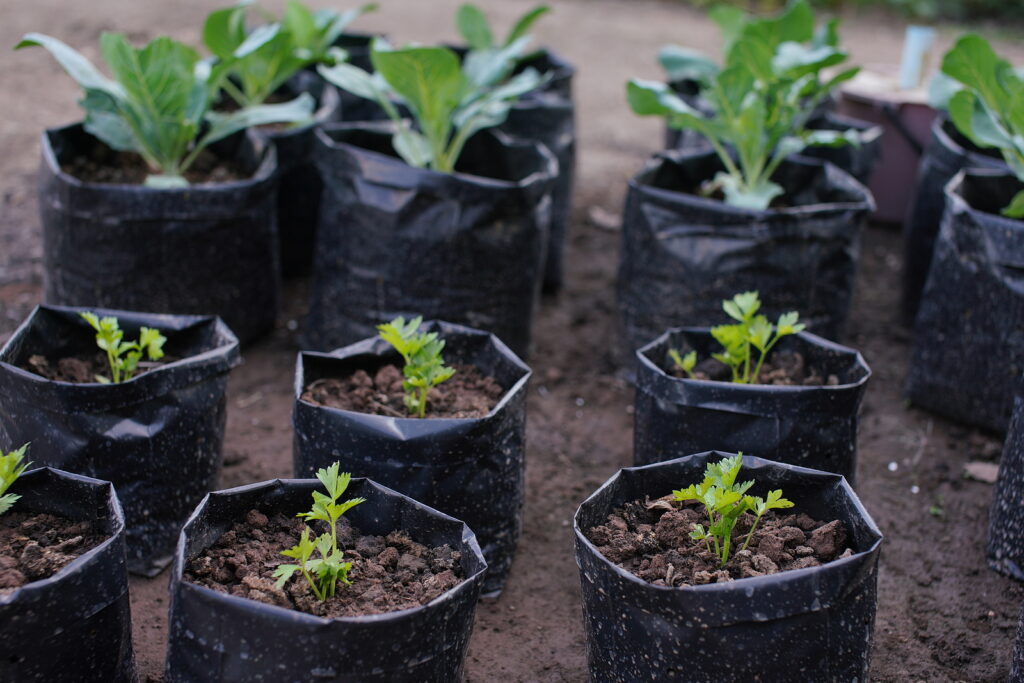
All-purpose grow bag soil mix
Here is a simple soil for grow bags:
- 1-part commercial potting mix
- 1-part garden soil
- 1-part compost (either commercial or homemade) or vermiculite
You mix these ingredients in a plastic pail, tub, or plastic garbage bag. Moisten the contents lightly with hot water to cut down on dust. Stir the combination slowly with a trowel or wooden spoon until everything is mixed. A large quantity can be mixed on a tarp on the driveway.
Ingredients for grow bag soil mix
Commercial potting mix
There are many commercial potting mixes available. Often used potting mixes are mixes developed by Cornell University and the University of California. These mixes are often modified and sold under commercial names like First Step, Jiffy Mix, Pro Mix, Redi Earth, and Super Soil. Commercial potting mixes commonly bark, compost, and peat moss—all are excellent for holding nutrients and moisture, though peat moss should be considered a non-renewable resource.
To see the Cornell University and the University of California soil mixes go to this post Soil and Planting Mediums for Containers.
Compost
Compost is made from a variety of fermented or decomposed organic materials—including manure, mushroom soil, straw, leaves, lawn clippings, vegetable refuse, sod, topsoil, muck, and sand. Compost is highly valuable as an organic fertilizer, and it improves soil texture.
Vermiculite
Vermiculite is mineral mica expanded by high heat. It can hold moisture for long periods of time.
Garden Soil (Loam)
A good garden soil or loam contains both organic matter and mineral matter. The soil particles are loose and allow for the free movement of air and water. Ideal garden soil will be about 50 percent solid organic matter and 50 percent air space.
Use only rich loamy soil in your grow bag mix. If you are unsure of the soil available in your garden, you should opt for topsoil available at a garden center. Purchased topsoil is usually sterilized and free of weed seeds, nematodes, and diseases.
Additional Soil Mix Additives
To a grow bag soil mix can be added organic fertilizers including the powdered forms of blood meal (nitrogen), bone meal (phosphorus), kelp meal (potassium), and worm castings (all around nutrients). Add organic fertilizers using the recommendation of manufacturers.
Related articles:
Container Vegetable Gardening Guide
Garden Planning Books at Amazon:

